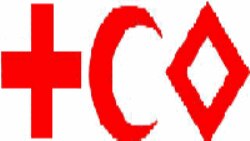Prague, 10 November 2005 (RFE/RL) -- Officially, the red cross and the red crescent -- the current emblems of the world’s most important humanitarian movement -- have no religious connotations.
However, Christian countries use the red cross, while predominantly Muslim societies have chosen the red crescent.
Now, the 192 signatory states of the Geneva Conventions are expected to find consensus on a third, nondenominational symbol during a conference on 5-6 December.
The Swiss government has said the new emblem, a red crystal, has no national, religious, or cultural connotations and could be used by national groups that reject the current symbols.
"Switzerland is looking for a consensus-oriented solution," Swiss Department of Foreign Affairs spokesman Lars Knuchel said. "Switzerland, in its function as the depository of the Geneva Conventions, is trying to bring along -- according to the will of all the contracting parties -- a solution that is going to fit all parties."
The conference venue is Geneva, the Swiss city that is also home to the humanitarian movement’s two main branches -- the International Committee of the Red Cross (ICRC) and the International Federation of Red Cross and Red Crescent Societies (IFRC).
The Red Cross movement was founded by Jean Henri Dunant of Switzerland in 1863. He had been profoundly moved by the atrocious scenes he had witnessed four years earlier on the northern Italian battlefield of Solferino, where tens of thousands of French, Italian, and Austrian soldiers were slaughtered. Injured soldiers on both sides were reportedly executed during or after the battle.
In 1983, the Red Cross organizations were formally linked with the similar Red Crescent societies in Muslim countries. In 1991, their common body was named the International Federation of Red Cross and Red Crescent Societies.
The four Geneva Conventions of 1949, which include provisions for the protection of prisoners, of the wounded, and of civilian populations in times of war, represent the basis of international humanitarian law. The conventions permit national humanitarian organizations to use either the cross or the crescent to identify themselves when working at home or abroad.
Due to religious considerations, however, countries such as Israel have declined to use either symbol. Israel has welcomed the idea of a third, nondenominational emblem, which would give it the opportunity to join the movement as a full member.
Israel’s rescue service, the Magen David Adom (MDA), has been denied full membership in the movement for 57 years and could not take part in international rescue missions because it uses a red Star of David to identify its ambulances and medical personnel.
Muslim countries have opposed Israel’s membership in the movement for decades. However, diplomatic reports indicate the mood has changed, allowing a good chance for the new symbol to be adopted.
"The moment the crystal will be an official emblem -- and we'll adopt it, hopefully, in a short time -- we'll be full members of the [Red Cross] movement. That's the whole idea," MDA liaison with the Red Cross movement Haim Dagan said.
The additional emblem could be used as a stand-alone symbol by current members under certain circumstances -- or the red cross, the red crescent, or the red Star of David could be incorporated inside the red crystal.
Alternatively, the red crystal alone could be adopted by countries with mixed religious traditions who are not yet members of the movement. ICRC’s spokeswoman Antonella Notari said that one such country is the troubled east African nation of Eritrea, which has a mixed Muslim and Christian population.
"Eritrea has had long and difficult discussions on whether to choose the cross or the crescent, and they've made a sort of halfway decision to use both, I think, at the present," Notari said. "There may be other countries who have a mixed population in terms of culture and religion. There are other countries who don't necessarily think that the cross or the crescent represent them adequately."
But Notari cautioned that -- even if adopted -- it will take time for the red crystal to earn respect and international recognition. "This emblem at the moment is something that exists on paper. It will have to become a reality. It will have to become something that is known and respected and filled with meaning," she said. "And therefore it might take some time before other organizations choose to use it."








